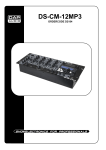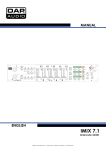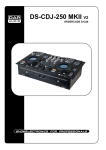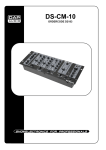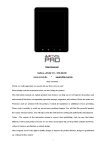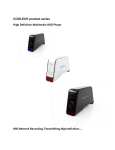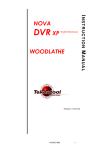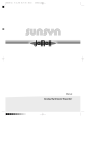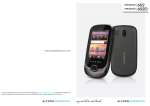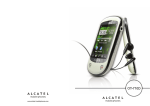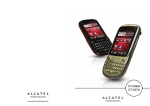Download DAPAudio DS-CM-10 Product guide
Transcript
DS-CM-8 ORDERCODE D2182 Congratulations! You have bought a great, innovative product from DAP Audio. The DAP Audio DS-CM-8 brings excitement to any venue. Whether you want simple plug-&-play action or a sophisticated show, this product provides the effect you need. You can rely on DAP Audio, for more excellent audio products. We design and manufacture professional audio equipment for the entertainment industry. New products are being launched regularly. We work hard to keep you, our customer, satisfied. For more information: [email protected] You can get some of the best quality, best priced products on the market from DAP Audio. So next time, turn to DAP Audio for more great audio equipment. Always get the best -- with DAP Audio ! Thank you! Dap Audio Dap Audio DS-CM-8™ Product Guide Warning....................................................................................................................................................................... 2 Unpacking Instructions......................................................................................................................................... 2 Safety-instructions................................................................................................................................................. 2 Operating Determinations................................................................................................................................... 3 Return Procedure.................................................................................................................................................. 4 Claims..................................................................................................................................................................... 4 Description.................................................................................................................................................................. 5 Overview................................................................................................................................................................ 5 Frontside................................................................................................................................................................. 5 Backside................................................................................................................................................................. 6 Installation................................................................................................................................................................... 6 Functions..................................................................................................................................................................... 6 Set Up and Operation................................................................................................................................................10 Maintenance.............................................................................................................................................................. 11 Replacing a fuse........................................................................................................................................................ 11 Replacing the crossfader..........................................................................................................................................12 Troubleshooting..........................................................................................................................................................12 Product Specifications...............................................................................................................................................13 1 WARNING FOR YOUR OWN SAFETY, PLEASE READ THIS USER MANUAL CAREFULLY BEFORE YOUR INITIAL START-UP! Unpacking Instructions Immediately upon receiving this product, carefully unpack the carton and check the contents to ensure that all parts are present, and have been received in good condition. Notify the dealer immediately and retain packing material for inspection if any parts appear damaged from shipping or the carton itself shows signs of mishandling. Save the carton and all packing materials. In the event that a fixture must be returned to the factory, it is important that the fixture be returned in the original factory box and packing. Your shipment includes: • DAP DS-CM-8 • IEC power cable – 1,65m • USB cable – 1,40m • User manual CAUTION! Keep this system away from rain and moisture! SAFETY INSTRUCTIONS Every person involved with the installation, operation and maintenance of this system has to: be qualified follow the instructions of this manual CAUTION! Be careful with your operations. With a dangerous voltage you can suffer a dangerous electric shock when touching the wires! Before you initial start-up, please make sure that there is no damage caused by transportation. Should there be any, consult your dealer and do not use the system. To maintain perfect condition and to ensure a safe operation, it is absolutely necessary for the user to follow the safety instructions and warning notes written in this manual. Please consider that damages caused by manual modifications to the system are not subject to warranty. This system contains no user-serviceable parts. Refer servicing to qualified technicians only. IMPORTANT: The manufacturer will not accept liability for any resulting damages caused by the nonobservance of this manual or any unauthorized modification to the system. Never let the power-cord come into contact with other cables! Handle the power-cord and all connections with the mains with particular caution! Never remove warning or informative labels from the unit. Never use anything to cover the ground contact. 2 Never leave any cables lying around. Do not insert objects into air vents. Do not connect this system to a dimmerpack. Do not switch the system on and off in short intervals, as this would reduce the system’s life. Do not open the device and do not modify the device. Do not drive the inputs with a signal level bigger, than required to drive the equipment to full output. Do not plug Mics into the console (or stagebox) while Phantom Power is on. Also mute the monitor / Pa system when turning Phantom Power on or off. Allow the system to adjust for a couple of seconds, before setting the input gains. Only use system indoor, avoid contact with water or other liquids. Avoid flames and do not put close to flammable liquids or gases. Always disconnect power from the mains, when system is not used. Only handle the power-cord by the plug. Never pull out the plug by tugging the power-cord. Always operate the unit with the AC ground wire connected to the electrical system ground. Make sure you don’t use the wrong kind of cables or defective cables. Make sure that the signals into the mixer are balanced, otherwise hum could be created. Make sure you use DI boxes to balance unbalanced signals; All incoming signals should be clear. Make sure that the available voltage is not higher than stated on the rear panel. Make sure that the power-cord is never crimped or damaged. Check the system and the powercord from time to time. Please turn off the power switch, when changing the power cord or signal cable, or select the input mode switch. Extreme frequency boosts in connection with a high input signal level may lead to overdriving your equipment. Should this occur, it is necessary to reduce the input signal level by using the INPUT control. To emphasize a frequency range, you don’t necessarily have to move its respective control upward; try lowering surrounding frequency ranges instead. This way, you avoid causing the next piece of equipment in your sound path to overdrive. You also preserve valuable dynamic reserve (“headroom”) Avoid ground loops! Always be sure to connect the power amps and the mixing console to the same electrical circuit to ensure the same phase! If system is dropped or struck, disconnect mains power supply immediately. Have a qualified engineer inspect for safety before operating. If the system has been exposed to drastic temperature fluctuation (e.g. after transportation), do not switch it on immediately. The arising condensation water might damage your system. Leave the system switched off until it has reached room temperature. If your Dap Audio device fails to work properly, discontinue use immediately. Pack the unit securely (preferably in the original packing material), and return it to your Dap Audio dealer for service. Repairs, servicing and electric connection must be carried out by a qualified technician. For replacement use fuses of same type and rating only. WARRANTY: Till one year after date of purchase. OPERATING DETERMINATIONS This system is not designed for permanent operation. Consistent operation breaks will ensure that the system will serve you for a long time without defects. If this system is operated in any other way, than the one described in this manual, the product may suffer damages and the warranty becomes void. Any other operation may lead to dangers like short-circuit, burns, electric shock, etc. You endanger your own safety and the safety of others! Improper installation can cause serious damage to people and property ! 3 Connection with the mains Connect the device to the mains with the power-plug. Always pay attention, that the right color cable is connected to the right place. International L N EU (including UK) From April 2004 Brown Blue Green/Yellow North America Pin Black White Green Phase Neutral Protective Earth Make sure that the device is always connected properly to earth! Return Procedure Returned merchandise must be sent prepaid and in the original packing, call tags will not be issued. Package must be clearly labeled with a Return Authorization Number (RMA number). Products returned without an RMA number will be refused. Highlite will not accept the returned goods or any responsibility. Call Highlite 0031-455667723 or mail [email protected] and request an RMA prior to shipping the fixture. Be prepared to provide the model number, serial number and a brief description of the cause for the return. Be sure to properly pack fixture, any shipping damage resulting from inadequate packaging is the customer’s responsibility. Highlite reserves the right to use its own discretion to repair or replace product(s). As a suggestion, proper UPS packing or double-boxing is always a safe method to use. Note: If you are given an RMA number, please include the following information on a piece of paper inside the box: 1) Your name 2) Your address 3) Your phone number 4) A brief description of the symptoms Claims The client has the obligation to check the delivered goods immediately upon delivery for any shortcomings and/or visible defects, or perform this check after our announcement that the goods are at their disposal. Damage incurred in shipping is the responsibility of the shipper; therefore the damage must be reported to the carrier upon receipt of merchandise. It is the customer's responsibility to notify and submit claims with the shipper in the event that a fixture is damaged due to shipping. Transportation damage has to be reported to us within one day after receipt of the delivery. Any return shipment has to be made post-paid at all times. Return shipments must be accompanied with a letter defining the reason for return shipment. Non-prepaid return shipments will be refused, unless otherwise agreed in writing. Complaints against us must be made known in writing or by fax within 10 working days after receipt of the invoice. After this period complaints will not be handled anymore. Complaints will only then be considered if the client has so far complied with all parts of the agreement, regardless of the agreement of which the obligation is resulting. 4 Description of the device Features Multifunctional Entertainment Mixer. • 10 inputs • 5 outputs • Assignable crossfader • Low, mid, high tone control for each channel • LED VU-meters for Master and PFL signal Overview Front Fig. 1 1) Mic Channel Mid 2) Mic Selection Control 3) Mic Channel High 4) Mic Input Balanced Input 5) Mic Channel Gain 6) Mic channel PFL Switch 7) Mic Channel Low 8) Mic Channel Mid 9) Talkover Switch 10) Channel 1-4 PFL Swich 11) Channel 1-4 Mid 12) Channel 1-4 Low 13) Channel 1-4 Fader 14) Channel 2 Line 1/ Phono 1 – USB input selector 15) Gain Control 16) Channel 1, 3, 4 Phono 1 - line2 input selector 17) Channel 1-4 PFL Switch 18) VU-meter section 19) Power ON LED 20) X-assign A 21) Crossfader 22) X-assign B 23) Booth 24) Power Switch 25) Headphone Volume 26) PFL/ PGM 27) Headphone 28) Master Volume Fader 5 Backside Fig. 2 29) Power Switch 30) Channel 4 L2 RCA Input 31) Channel 4 CD/ Phono Selector 32) Channel 3 L2 RCA Input 33) Channel 3 CD/ Phono Selector 34) Channel 2 L2 RCA Input 35) Channel 2 CD/ Phono Selector 36) Channel 1 CD/ Phono Selector 37) Channel 1 PH1/L1 RCA Input 38) GND 39) AC Inlet with integrated fuse holder 40) Master RCA Balanced Out 41) Master RCA Unbalanced Out 42) Booth RCA Out 43) Rec RCA Out 44) Channel 4 PH1/L1 RCA Input 45) Channel 3 PH1/L1 RCA Input 46) Channel 2 PH1/L1 RCA Input 47) Channel 1 L2 RCA Input 48) Mic 2 Jack Unbalanced Input 49) USB port Installation Remove all packing materials from the DS-CM-8. Check that all foam and plastic padding is removed. Connect all cables. Always disconnect from electric mains power supply before cleaning or servicing. Damages caused by non-observance are not subject to warranty. Functions 1 /3 / 7. EQ HIGH/MID/LOW The mic channel is fitted with 3-band EQ. The upper (3) and lower (7) shelving controls have their frequencies fixed at 10 Khz and 100 Hz respectively. The Mid range control (1) has a center frequency of 1 kHz. All 3 bands have up to 12 dB cut and boost, with a centre detent for “OFF”. Turning the Equalizer level control to the right amplifies the frequency range, turning to the left attenuates the signal. Minor changes to the Equalizer control usually produce the best results. Try to avoid excessive enhancement of the MID band. 2. Mic Selection Mixes Mic 1 and Mic 2. If the conrol is set completely to the left only Mic 1 Will be heard. If the control is turned completely to the right, only Mic 2 will be heard. 4. Mic Electronically balanced XLR-type input for connecting low impedance microphone. The input has extremely low noise. When connecting a microphone make sure that the pin assignment is correct. Always make Fig 3. sure to read the manual of the microphone you want to connect. The Mic- input is not suitable for connecting an additional mixing console, FXunit, etc. You have to use one of the LINE- inputs, when connecting this kind of equipment. 6 Note: When connecting signal sources, please make sure that the corresponding channel faders and the master faders are at minimum settings. Otherwise, unpleasant plug-in noise can occur. 5. Mic Gain Use this control to match the connected microphones optimally to your DS-CM-8. 6. PFL The PFL button (pre fade listening) is designed to route the Mic channel input to the monitor section independent of the individual channel’s volume fader setting. It is possible to assign more than one channel simultaneously to the PFL bus. 8. PAN By using the PAN control you can change the input signal’s position within the stereo image. When the PAN control is set to center position, the audio signal is equal for both the left and right bus. 9. Talkover Button With this button pressed, the talkover function is activated and channel 1-4 are attenuated 12dB. Fig. 4 10 /11 / 12. EQ HIGH/MID/LOW The mixer’s Equalizer section allows shaping of the outgoing audio signal. Channels 1-4 are fitted with a 3-band EQ. The upper shelving control’s (10) frequency shifts with the boost/ cut range from 70Hz at -26dB to 100Hz at +12dB. The Lower shelving control’s (12) frequency shifts with the boost/ cut range from 20kHz at -22dB to 10kHz at +12dB. The Mid range control (11) has a center frequency of 2.5 kHz. The Mid band can be boost or cut with 12dB. All 3 bands have a centre detent for “OFF”. Turning the Equalizer level control to the right amplifies the frequency range, turning to the left attenuates the signal. Minor changes to the Equalizer control usually produce the best results. Try to avoid excessive enhancement of the MID band. 13. Channel Fader A logarithmic 45mm fader, which controls the volume of its’ channel. The faders should be positioned within range of -12dB to 0dB, leaving you with sufficient room to allow precise matching of differences in the channel’s level settings. The overall volume is set with the master fader. Even though the channel faders offer an additional gain of +6dB, it is better not to exceed the +0dB position by default. 14. Selection Switch (Line 1/Phono 1 - USB) With this switch you can select between two sets of inputs per channel. 15. Gain Use this control to match the connected devices optimally to your DS-CM-8. Turn the gain control all the way to the left at minimum position, the channel and master faders to 0dB. Adjust the gain with a loud input signal in such a way that the Master VU- meter RED leds do not light. 16. Selection Switch (Line 1/Phono - Line 2) With this switch you can select between two sets of inputs per channel. Set the L1/PHONO (31, 33, 35, 36) selector in phono position if you want to connect a turntable. To the PHL1 (44, 45, 37) or the Phono (46) input on the rearpanel. 17. PFL The PFL button (pre fade listening) is designed to route the channel input to the monitor section independent of the individual channel’s volume fader setting. It is possible to assign more than one channel simultaneously to the PFL bus. 7 18. Output Signal VU Meter The DS-CM-8 features 3 VU-meters. This meter is a multi-step LED; The level indication allows you to monitor the Left and Right output and the PFL signal level at anytime, and match with other devices. 19. Power LED Indicates that the DS-CM-8 is active. 20. X-assign A Use this switch to assign the Right-side of the crossfader (21) to an input channel (zero is Off). 21. Crossfader The crossfader allows you to mix evenly from one channel to another channel. Fig. 5 22. X-assign B Use this switch to assign the Left-side of the crossfader (21) to an input channel (zero is Off). 23. Booth Control This control allows you to adjust the volume of the Booth output (43). Use to set the balance between the Left and right master output. 24. Headphones Volume Fig. 6 This control allows you to adjust the headphones’ volume. 25. PFL Split/ Blend Switch This switch controls the routing to your headphone. In split mode the PFL signal is send to the Left ear of the headphone connected to the Headphone output (27) the Master signal is send to the Right ear of the headphone. In Blend mode the PFL and master signal are send to both ears of the headphone. 26. CF Monitor Use this control to make a headphone mix between your PFL and your master signal. 27. Headphone You can connect a pair of headphones with an impedance of 32 - 600 Ohm to the headphones connector. It is a 6,3mm/ 1/4” TRS socket, wired as Tip=left, Ring=right and sleeve = ground. Caution: Depending on the type of headphones connected to the Headphones jack, the DS-CM-8 is capable of producing high output levels via the phones output. Therefore, make sure to turn the control all the way to the left (minimum setting) before connecting the headphones. Be aware of the fact that listening to loud sound pressure levels over a longer period of time leads to hearing-damage! 28. Master You can adjust the output signal to the Master Outputs (40/41). Fig. 7 8 Fig. 8 29. Power Switch 30. Channel 4 L2 RCA Input Use to connect a line level device. 31. Channel 4 CD/PHONO Selector Used to set the input level for the PHL1 Input (52) to either phono or line level. 32. Channel 3 L2 RCA Input Use to connect a line level device. 33. Channel 3 CD/PHONO Selector Used to set the input level for the PHL1 Input (48) to either phono or line level. 34. Channel 2 L1 RCA Input Use to connect a line level device. 35. Channel 2 CD/PHONO Selector Used to route either the L1 or PHONO inputs to the LINE 1/ PHONO – USB switch (14). 36. Channel 1 CD/PHONO Selector Used to set the input level for the PHL1 Input (52) to either phono or line level. 37. Channel 1 PH/L1 RCA Input Use to connect either a phono or line level device depending on the position of the Channel 1 CD/ PHONO switch (38). 38. GND Use to connect the ground wire of your turntable. 39. AC Inlet with integrated fuse holder. This connector is meant for the connection of the supplied main cord. Connect one end of the power cord to the connector, the other end to the mains, then turn on the power switch to operate the unit. Note: Please make sure that the supply voltage matches the operation voltage before connecting the unit to mains. Replace the fuse only with a fuse of same specification (T250mA). 40. Master RCA balanced Out Use these outputs to connect an amplifier with balanced inputs. 41. Master RCA Unbalanced Out Use these outputs to connect an amplifier with unbalanced inputs. 42. Booth RCA Unbalanced Out Use these outputs to connect you Booth monitor amplifier with unbalanced inputs. 43. Record RCA Unbalanced Out Use these to connect a recording device. 44. Channel 4 PH1/L1 RCA Input Use to connect a line level device. 45. Channel 3 PH/L1 RCA Input Use to connect either a phono or line level device depending on the position of the Channel 3 CD/ PHONO switch (36). 46. Channel 2 PHONO RCA Input Use to connect either a phono level device. PHONO switch (37). 47. Channel 1 L2 RCA Input Use to connect a line level device. 48. MIC 2 Jack Unbalanced Input MIC 2 channel ¼” unbalanced microphone input. 49. USB Aux In/ Out This USB port can be used to connect the DS-CM-8 to your PC/ laptop. You can use this connector For playback or record with your favourate mediaplayer. 9 Set Up and Operation Before plugging the unit in, always make sure that the power supply matches the product specification voltage. Do not attempt to operate a 120V specification product on 230V power, or vice versa. Connection Cables Take care of your cables, always holding them by the connectors and avoiding knots and twists when coiling them: This gives the advantage of increasing their life and reliability. Periodically check your cables. A great number of problems (faulty contacts, ground hum, discharges, etc.) are caused entirely by using unsuitable or faulty cables. Headphones Unbalanced mono Balanced mono 10 Insert Compensation of interference with balanced connections Maintenance The DAP Audio-CD-Player DS-CM-8 requires almost no maintenance. However, you should keep the unit clean. Disconnect the mains power supply, and then wipe the cover with a damp cloth. Do not immerse in liquid. Do not use alcohol or solvents. Keep connections clean. Disconnect electric power, and then wipe the audio connections with a damp cloth. Make sure connections are thoroughly dry before linking equipment or supplying electric power. Replacing a Fuse Power surges, short-circuit or inappropriate electrical power supply may cause a fuse to burn out. If the fuse burns out, the product will not function whatsoever. If this happens, follow the directions below to do so. 1. Unplug the unit from electric power source. 2. Insert a flat-head screwdriver into a slot in the fuse cover. Gently pry up the fuse cover. The fuse will come out. 3. Remove the broken fuse. If brown or unclear, it is burned out. 4. Insert the replacement fuse into the holder where the old fuse was. Reinsert the fuse cover. Be sure to use a fuse of the same type and specification. See the product specification label for details. 11 Replacing the crossfader 1. Unscrew the fader(B) screws. Do not touch the innerscrews(C). Carefully remove the old crossfader and unplug the cable.(D) 2. Plug in the new Crossfader, attach the cable (D)and place the new Crossfader back in the mixer. 3. Screw the Crossfader into the mixer using the fader plate screws. 4. Replace the fader knob. Fig. 9 Troubleshooting DAP Audio-CD-Player DS-CM-8 This troubleshooting guide is meant to help solve simple problems. If a problem occurs, carry out the steps below in sequence until a solution is found. Once the unit operates properly, do not carry out following steps. 1. If the device does not operate properly, unplug the device. 2. Check power from the wall, all cables, connections, etc. 3. If all of the above appears to be O.K., plug the unit in again. 4. If nothing happens after 30 seconds, unplug the device. 5. Return the device to your DAP Audio dealer. 12 Product Specification Model: Power: Fuse: Weight: Dimensions: Input sensitivity Output level Frequency response: THD: Stereo separation: Signal/ noise ratio Equalizer: Dap Audio DS-CM-8 230V-50/60Hz T250mA 3,9 kg 483 x 180 x 105mm (LxWxD) mic: 3mV/ 1kΩ line: 3mV/ 47kΩ phono: 150mV/ 100kΩ aux: 150mV/ 100kΩ master: 775mV/ 600Ω Record: 400mV/ 600Ω Phones: 400mV/ 8Ω 20Hz – 20kHz < 0,1% >45dB mic: 75dB phono: 70dB line: 80dB aux: 80dB Mic Channel: LOW +/-12dB at 100Hz MID +/-12dB at 1kHz HIGH +/-12dB at 10kHz Channel 1-4: LOW -26dB at 70Hz/ +12dB at 100kHz MID -30dB at 1kHz/ +12dB at 1kHz HIGH -22dB at 20kHz/ +12dB at 10kHz Design and product specifications are subject to change without prior notice. Website: www.Dap-audio.info Email: [email protected] 13 2009 Dap Audio.
















